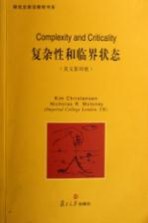图书介绍
复杂性和临界状态PDF|Epub|txt|kindle电子书版本网盘下载

- (英)克里斯蒂森,(英)莫洛尼著 著
- 出版社: 上海:复旦大学出版社
- ISBN:7309052021
- 出版时间:2006
- 标注页数:392页
- 文件大小:103MB
- 文件页数:421页
- 主题词:复杂性理论-物理模型-研究生-教学参考资料-英文;临界状态-物理模型-研究生-教学参考资料-英文
PDF下载
下载说明
复杂性和临界状态PDF格式电子书版下载
下载的文件为RAR压缩包。需要使用解压软件进行解压得到PDF格式图书。建议使用BT下载工具Free Download Manager进行下载,简称FDM(免费,没有广告,支持多平台)。本站资源全部打包为BT种子。所以需要使用专业的BT下载软件进行下载。如BitComet qBittorrent uTorrent等BT下载工具。迅雷目前由于本站不是热门资源。不推荐使用!后期资源热门了。安装了迅雷也可以迅雷进行下载!
(文件页数 要大于 标注页数,上中下等多册电子书除外)
注意:本站所有压缩包均有解压码: 点击下载压缩包解压工具
图书目录
1.Percolation1
1.1 Introduction1
1.1.1 Definition of site percolation3
1.1.2 Quantities of interest3
1.2 Percolation in d=15
1.2.1 Cluster number density6
1.2.2 Average cluster size8
1.2.3 Transition to percolation13
1.2.4 Correlation function13
1.2.5 Critical occupation probability14
1.3 Percolation on the Bethe Lattice15
1.3.1 Definition of the Bethe lattice15
1.3.2 Critical occupation probability16
1.3.3 Average cluster size16
1.3.4 Transition to percolation19
1.3.5 Cluster number density22
1.3.6 Correlation function29
1.4 Percolation in d=230
1.4.1 Transition to percolation31
1.4.2 Average cluster size33
1.4.3 Cluster number density-exact35
1.4.4 Cluster number density-numerical35
1.5 Cluster Number Density-Scaling Ansatz39
1.5.1 Scaling function and data collapse41
1.5.2 Scaling function and data collapse in d=142
1.5.3 Scaling function and data collapse on the Bethe lattice44
1.5.4 Scaling function and data collapse in d=249
1.6 Scaling Relations51
1.7 Geometric Properties of Clusters55
1.7.1 Self-similarity and fractal dimension55
1.7.2 Mass of a large but finite cluster at p=pc58
1.7.3 Correlation length62
1.7.4 Mass of the percolating cluster for p>pc63
1.8 Finite-Size Scaling69
1.8.1 Order parameter70
1.8.2 Average cluster size and higher moments73
1.8.3 Cluster number density75
1.9 Non-Universal Critical Occupation Probabilities78
1.10 Universal Critical Exponents81
1.11 Real-Space Renormalisation82
1.11.1 Self-similarity and the correlation length82
1.11.2 Self-similarity and fixed points83
1.11.3 Coarse graining and rescaling85
1.11.4 Real-space renormalisation group procedure87
1.11.5 Renormalisation in d=191
1.11.6 Renormalisation in d=2 on a triangular lattice95
1.11.7 Renormalisation in d=2 on a square lattice98
1.11.8 Approximation via the truncation of parameter space100
1.12 Summary102
Exercises104
2.Ising Model115
2.1 Introduction115
2.1.1 Definition of the Ising model116
2.1.2 Review of equilibrium statistical mechanics119
2.1.3 Thermodynamic limit123
2.2 System of Non-Interacting Spins124
2.2.1 Partition function and free energy125
2.2.2 Magnetisation and susceptibility127
2.2.3 Energy and specific heat129
2.3 Quantities of Interest131
2.3.1 Magnetisation131
2.3.2 Response functions133
2.3.3 Correlation length and spin-spin correlation function134
2.3.4 Critical temperature and external field135
2.3.5 Symmetry breaking138
2.4 Ising Model in d=1140
2.4.1 Partition function141
2.4.2 Free energy143
2.4.3 Magnetisation and susceptibility145
2.4.4 Energy and specific heat149
2.4.5 Correlation function151
2.4.6 Critical temperature154
2.5 Mean-Field Theory of the Ising Model156
2.5.1 Partition function and free energy157
2.5.2 Magnetisation and susceptibility158
2.5.3 Energy and specific heat166
2.6 Landau Theory of the Ising Model169
2.6.1 Free energy170
2.6.2 Magnetisation and susceptibility172
2.6.3 Specific heat175
2.7 Landau Theory of Continuous Phase Transitions175
2.8 Ising Model in d=2179
2.8.1 Partition function179
2.8.2 Magnetisation and susceptibility180
2.8.3 Energy and specific heat184
2.8.4 Critical temperature186
2.9 Widom Scaling Ansatz188
2.9.1 Scaling ansatz for the free energy190
2.9.2 Scaling ansatz for the specific heat191
2.9.3 Scaling ansatz for the magnetisation191
2.9.4 Scaling ansatz for the susceptibility192
2.9.5 Scaling ansatz for the spin-spin correlation function192
2.10 Scaling Relations193
2.11 Widom Scaling Form and Critical Exponents in d=1195
2.12 Non-Universal Critical Temperatures198
2.13 Universal Critical Exponents199
2.14 Ginzburg Criterion200
2.15 Real-Space Renormalisation202
2.15.1 Kadanoff's block spin transformation202
2.15.2 Kadanoff's block spin and the free energy206
2.15.3 Kadanoff's block spin and the correlation function209
2.15.4 Renormalisation in d=1211
2.15.5 Renormalisation in d=2 on a square lattice215
2.16 Wilson's Renormalisation Group Theory222
2.16.1 Coupling space and renormalisation group flow222
2.16.2 Self-similarity and fixed points227
2.16.3 Basin of attraction of fixed points229
2.16.4 RG flow in coupling and configurational space230
2.16.5 Universality and RG flow near fixed point231
2.16.6 Widom scaling form235
2.17 Summary237
Exercises241
3.Self-Organised Criticality249
3.1 Introduction249
3.1.1 Sandpile metaphor250
3.2 BTW Model in d=1255
3.2.1 Algorithm of the BTW model in d=1256
3.2.2 Transient and recurrent configurations257
3.2.3 Avalanche time series259
3.2.4 Avalanche-size probability260
3.3 Mean-Field Theory of the BTW Model264
3.3.1 Random neighbour BTW model264
3.3.2 Algorithm of the random neighbour BTW model264
3.3.3 Steady state and the average avalanche size265
3.4 Branching Process267
3.4.1 Branching ratio267
3.4.2 Avalanche-size probability-exact268
3.4.3 Avalanche-size probability-scaling form270
3.5 Avalanche-Size Probability-Scaling Ansatz273
3.6 Scaling Relations275
3.7 Moment Analysis of Avalanche-Size Probability276
3.8 BTW Model in d=2278
3.8.1 Algorithm of the BTW model in d=2278
3.8.2 Steady state and the average avalanche size279
3.8.3 Avalanche time series280
3.8.4 Avalanche-size probability281
3.9 Ricepile Experiment and the Oslo Model285
3.9.1 Ricepile experiment285
3.9.2 Ricepile avalanche time series287
3.9.3 Ricepile avalanche-size probability density289
3.9.4 Ricepile modelling290
3.9.5 Algorithm of the Oslo model291
3.9.6 Transient and recurrent configurations292
3.9.7 Avalanche time series293
3.9.8 Avalanche-size probability294
3.10 Earthquakes and the OFC Model302
3.10.1 Earthquake mechanism302
3.10.2 Earthquake time series303
3.10.3 Earthquake-size frequency304
3.10.4 Earthquake modelling305
3.10.5 Algorithm of the OFC model309
3.10.6 Steady state and the average avalanche size310
3.10.7 Avalanche time series314
3.10.8 Avalanche-size probability318
3.11 Rainfall325
3.11.1 Rainfall mechanism325
3.11.2 Rainfall time series326
3.11.3 Rainfall-size number density329
3.12 Summary331
Exercises334
Appendix A Taylor Expansion341
Appendix B Hyperbolic Functions343
Appendix C Homogeneous and Scaling Functions345
Appendix D Fractals351
Appendix E Data Binning355
Appendix F Boltzmann Distribution359
Appendix G Free Energy361
Appendix H Metropolis Algorithm363
Bibliography365
List of Symbols371
Index381